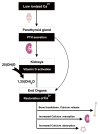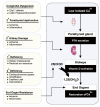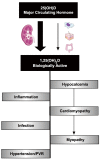Vitamin D deficiency in surgical congenital heart disease: prevalence and relevance
- PMID: 26835300
- PMCID: PMC4728932
- DOI: 10.3978/j.issn.2224-4336.2013.07.03
Vitamin D deficiency in surgical congenital heart disease: prevalence and relevance
Abstract
Vitamin D is a pleiotropic hormone important for the proper functioning of multiple organ systems. An emerging body of adult and pediatric critical care literature strongly suggests that vitamin D deficiency contributes to secondary organ pathophysiology, prolongs ICU stay, and worsens outcome in critically ill populations. Recent clinical studies suggest that a significant number of children with congenital heart disease (CHD) have post-operative vitamin D deficiency which appears to be associated with greater cardiovascular dysfunction. Altogether the cumulative body of literature suggests that peri-operative optimization of vitamin D status has the potential to speed recovery and/or improve outcome. This review describes the epidemiological and basic science research linking vitamin D deficiency to post-operative organ dysfunction. Furthermore, the available supplementation approaches are reviewed in the context of prevention of post-operative vitamin D deficiency and avoidance of toxicity in the majority of CHD patients. Finally, knowledge gaps regarding vitamin D supplementation are identified and the next stages for research are outlined.
Keywords: 25 hydroxyvitamin D; Vitamin D deficiency; cardiopulmonary bypass; congenital heart disease(CHD); surgery; toxicity; vitamin D supplementation.
Conflict of interest statement
Figures



Similar articles
-
Impact of anesthesia and surgery for congenital heart disease on the vitamin d status of infants and children: a prospective longitudinal study.Anesthesiology. 2013 Jul;119(1):71-80. doi: 10.1097/ALN.0b013e31828ce817. Anesthesiology. 2013. PMID: 23470437
-
Vitamin D Deficiency in Pediatric Critical Care.J Pediatr Intensive Care. 2016 Dec;5(4):142-153. doi: 10.1055/s-0036-1583285. Epub 2016 May 4. J Pediatr Intensive Care. 2016. PMID: 31110899 Free PMC article. Review.
-
The association of vitamin D status with pediatric critical illness.Pediatrics. 2012 Sep;130(3):429-36. doi: 10.1542/peds.2011-3059. Epub 2012 Aug 6. Pediatrics. 2012. PMID: 22869837
-
The relationship between vitamin D status and adrenal insufficiency in critically ill children.J Clin Endocrinol Metab. 2013 May;98(5):E877-81. doi: 10.1210/jc.2013-1126. Epub 2013 Apr 1. J Clin Endocrinol Metab. 2013. PMID: 23547046
-
Vitamin D supplementation in the ICU patient.Curr Opin Clin Nutr Metab Care. 2015 Mar;18(2):187-92. doi: 10.1097/MCO.0000000000000147. Curr Opin Clin Nutr Metab Care. 2015. PMID: 25635597 Review.
Cited by
-
Vitamin D and Cardiovascular Diseases: An Update.Cureus. 2023 Nov 30;15(11):e49734. doi: 10.7759/cureus.49734. eCollection 2023 Nov. Cureus. 2023. PMID: 38161941 Free PMC article. Review.
-
Increased Fracture Risk with Furosemide Use in Children with Congenital Heart Disease.J Pediatr. 2018 Aug;199:92-98.e10. doi: 10.1016/j.jpeds.2018.03.077. Epub 2018 May 9. J Pediatr. 2018. PMID: 29753543 Free PMC article.
-
Plasma 25-hydroxyvitamin D2 and D3 levels and incidence of postoperative atrial fibrillation.J Nutr Sci. 2016 Feb 15;5:e10. doi: 10.1017/jns.2015.38. eCollection 2016. J Nutr Sci. 2016. PMID: 27066255 Free PMC article.
-
Serum vitamin D status following pediatric cardiac surgery and association with clinical outcome.Eur J Pediatr. 2020 Apr;179(4):635-643. doi: 10.1007/s00431-019-03538-x. Epub 2019 Dec 21. Eur J Pediatr. 2020. PMID: 31865429
-
Understanding vitamin D deficiency in intensive care patients.Intensive Care Med. 2015 Nov;41(11):1961-4. doi: 10.1007/s00134-015-3937-4. Epub 2015 Jul 4. Intensive Care Med. 2015. PMID: 26142054 No abstract available.
References
-
- Hoffman JI, Kaplan S. The incidence of congenital heart disease. J Am Coll Cardiol 2002;39:1890-900. - PubMed
-
- Brix-Christensen V. The systemic inflammatory response after cardiac surgery with cardiopulmonary bypass in children. Acta Anaesthesiol Scand 2001;45:671-9. - PubMed
-
- Gazit AZ, Huddleston CB, Checchia PA, et al. Care of the pediatric cardiac surgery patient--part 1. Curr Probl Surg 2010;47:185-250. - PubMed
-
- McEwan A. Aspects of bleeding after cardiac surgery in children. Paediatr Anaesth 2007;17:1126-33. - PubMed
-
- Dyke PC, 2nd, Yates AR, Cua CL, et al. Increased calcium supplementation is associated with morbidity and mortality in the infant postoperative cardiac patient. Pediatr Crit Care Med 2007;8:254-7. - PubMed
Publication types
LinkOut - more resources
Full Text Sources
